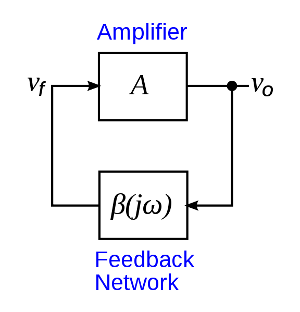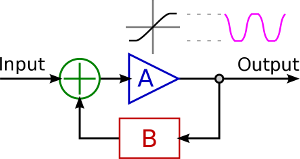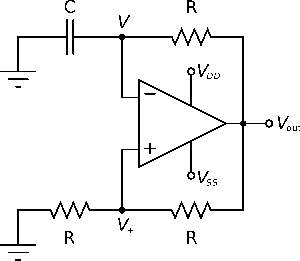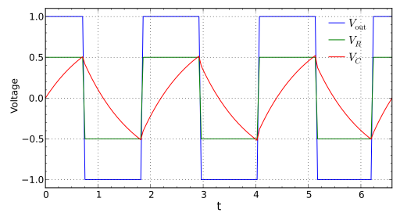We saw in the previous introductory article that the ice-ages appear to come and go about every 120,000 years. Their shape suggests a fast rise in temperature followed by a slow decline which is indicative of some kind of cyclic behaviour to the climate. This can occur for two reasons:
- Because there is some form of driver whose effect is cyclic. Obvious ones are the yearly cycle of the earth around the sun which obviously forces the climate to follow a similar yearly cycle on top of any other changes
- Because the climate is inherently unstable.

Fig 2.1 Block diagram of a feedback oscillator circuit to which the Barkhausen criterion applies. It consists of an amplifying element A whose output vo is fed back into its input vf through a feedback network β(jω).
As no appropriate external cycle with a period of around 120,000 years capable of driving the climate has been found the first can be ruled out. Therefore is it likely the climate is in some way unstable. So what makes a system oscillate and imposes this kind of cyclic behaviour? The answer comes in terms of the criteria for a system to oscillate in this manner.
The Barkhausen stability criterion that if A is the gain of the amplifying element in the circuit and β(jω) is the transfer function of the feedback path, so that βA is the loop gain around the feedback loop of the circuit, the circuit will sustain steady-state oscillations where:
- The system has feedback
- At the frequency of oscillation the feedback has no phase shift around the feedback loop or it is delayed by an integer number of cycles
- And the loop gain around the circuit is equal to unity
So the key requirement for oscillation is that there is feedback. However a gain of precisely unity is highly unlikely and so in a practical system, the output is limited. In an electronic amplifier the output is limited because the output cannot exceed either +ve or -ve power supply. This effectively reduces the gain at these points so the output is reduced (clipped) for any change of input. In this case the the circuit will sustain steady-state oscillations where:
- The system has feedback with gain >1
- At the frequency of oscillation the feedback has no phase shift or it is delayed by an integer number of cycles.
As the gain of the amplifier increases, the output tends more and more to be either high or low until it is effectively a bi-state square wave.
Such a circuit is shown to the right in fig 2.3 and the waveforms at key points are shown in fig 2.4.
In this case, the output (blue) switches between ±1.0V. The lower pair of resistors halve this value (green) so that the positive input (+) is ±0.5V. The other input to the amplifier (-) is fed by a resistor feeding a capacitor producing a near triangular wave (red).
So, what’s this got to do with climate? The key element in this oscillator is the RC network which determines the timing. The time to change from one transition voltage to the next is proportional to R x C.
So main features of a system with oscillations are:
- Positive feedback large enough so that a change in the input feeds back as a still larger change.
- An upper & lower switching threshold each of when reached cause a change in state so that the system then tends toward the other switching threshold
- A delay or other timing element such as the RC network.
Therefore, if we see self-induced cycles in the natural world, we should expect to see all these elements and physical systems reproducing such elements such as the time delay from the RC network.
Locked or triggered Oscillation
Finally I wish to cover the issue of “locking” of an oscillation of one frequency to a cycle of another.
In the above model, the two NAND gates (U1, U2) form a monostable pulse generator such that when the input signal rises above Vref at time t1, it causes the pair of NAND gates to flip. So the output of U2 goes high and it is locked in this state even though the input then drops below Vref at t2 because U1 goes low so that it doesn’t matter what the input to U3 is. However, eventually R1 discharges C1 causing the voltage across R1 to drop and the output of U1 goes low (t3). Now as soon as U3 goes low again (t4) , the cycle will repeat. However, note that now the cycle will repeat after the delay from the time constant R1.C1 and then at the next high input. In this way the exact start of cycle is locked to the input signal, but the overall time must be greater than the delay introduced by R1.C1.
See also:






The problem as I see it is that we do not have enough data and enough good data.
The more I see of Solar Scientists and their Hubris the less I trust anything they have to say about the sun far back in history as they couldn’t get this solar cycle right and they still don’t know how the sun works.
I have little confidence in the Ice Core Data, especially the actual mechanism for how the CO2 is stored and how it remains, ie does it represent the amount in the atmosphere at the time, does it remain the same, reduce or even increase.
We also know too little about Astro Physics, for instance how do we know that the Solar system does no pass through space dust clouds that reduce solar insolation by dimming the sun.
Everybody thinks inside the “Earth” box and just maybe the answers are not all inside it.
The ice-core figures have been a real pain writing this, because we simply do not know whether what we see is accurate. And I’m sure it would have been relatively simple to have checked such things as the release of CO2 due to microcracks if they had really wanted to know how much the change/level in CO2 when the ice is brought up reflects the change/level of CO2 we would see in the ice if we took the readings at depth and therefore under pressure without the release of some of the gas.
What would it have taken, to put some heater on the end of the drill, heated the ice and collected the gas sample whilst the ice was still (largely) under pressure? We take gas samples on Mars – but we can’t get gas sample from under the Antarctic ice? That’s bizarre! Or more likely they don’t want to get gas samples as CO2 is only likely to be higher which doesn’t suit certain people.
Pingback: Toward a new theory of iceages VI (Climate stability) | Scottish Sceptic
Pingback: Toward a new theory of ice-ages VII (hitting the buffers) | Scottish Sceptic
Pingback: Toward a new theory of ice-ages VIII (How CO2 could control climate) | Scottish Sceptic
Hi Mike Haseler/Scottish Sceptic. Promised to come over here, read your work, and comment. Congratulations on posting despite hitting a dead end per the intro.
No quibbles with the circuit model analogies. Built a varactor digital metronome as a kid; my father had a masters in EE and a masters in meteorology, both courtesy USAF. He would have certainly agreed with you.
There is another essential diagnostic here that would validate any model. The Pleistocene ice ages began about 2.5mya. Up until about 1mya the cyclic period frequency was ~41ky. Then quite suddenly it switched to ~120kya where it has remained. You can easily google many graphic representations; I think wikipedia may have a reliable one. Any good theoretical explanation needs also to explain this switch. This is one of the main weaknesses in the Milankovich theory.
Hi, you’ve obviously not read the later article: http://scottishsceptic.co.uk/2015/02/12/toward-a-new-theory-of-ice-ages-x-5million-years-of-cycles/
What I suggest is that the crustal contraction that occurs as we cool continues until the rate of cooling slows, so that the relatively small size of warming from the Milankovitch cycle is big enough to cause net warming, stop the contraction and precipitate crustal subduction. This then leads to emissions (various possible but CO2 is obviously a contender) which lead to runaway warming and further crustal expansion.
For some reason, however whereas the average temperature drops, the peak temperature of the interglacial remains fairly steady. The effect is that we see a progressively larger swing.
The sudden transition (not as sudden as you suggest) is likely the result of the increased size of the warming/cooling swing. With a small swing, the cooling quickly trails off so that it is ready for the next Milankovitch cycle. However, as the swing increases in magnitude, the rate of cooling becomes too large so that the warming from the next Milankovitch cycle is not sufficient to cause net warming. So, we effectively “miss the bus”, the Milankovitch cycle goes into cooling and only at the next rise is has the cooling of the crust reduced sufficiently to allow the modest warming from the Milankovitch cycle to trigger another round of warming.
Pingback: Toward a new theory of ice-ages III (Global Warming and Earthquakes) | Scottish Sceptic
Pingback: Toward a new theory of ice-ages IV (Thermal crust expansion, decomposition and the Carbon cycle) | Scottish Sceptic
Pingback: Toward a new theory of ice-ages XIV (Putting it all together) | Scottish Sceptic
Mike Haseler,
I have been working on the idea of thermal expansion and contraction of the ocean crust as a mechanism of plate tectonics for some 33 years. Check my website for some recent papers. It is very difficult to publish this idea as you can see from the discussion on my website. The mechanism, like yours, is based upon an analogy to the way expansion and contraction works on lake ice forming pressure ridges and ice ramparts.
Perhaps we can have a discussion on plate tectonics. there are some difference between you proposal and mine.
Jon Thoreau Scott
Jon, great to read your comments and glad to co-operate. I think it might help to explain how my idea developed. I was trying to understand how the Milankovitch cycle could result in a much larger change in temperature in climate than the cycle direct. I needed some way that “pressure” in the system would be built up over a period of ~100,000 years so that something could be triggered. I realised that such a slow build up needed something slow like thermal conduction through the crust. The suggestion of volcanic activity is a way to link the “trigger” of thermal expansion to potential climate and positive feedback warming.